

Handbook. What are reduced penetrance and variable expressivity? Reduced penetrance and variable expressivity are factors that influence the effects of particular genetic changes.
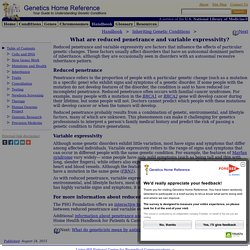
These factors usually affect disorders that have an autosomal dominant pattern of inheritance, although they are occasionally seen in disorders with an autosomal recessive inheritance pattern. Reduced penetrance Penetrance refers to the proportion of people with a particular genetic change (such as a mutation in a specific gene) who exhibit signs and symptoms of a genetic disorder. If some people with the mutation do not develop features of the disorder, the condition is said to have reduced (or incomplete) penetrance. Reduced penetrance often occurs with familial cancer syndromes. Reduced penetrance probably results from a combination of genetic, environmental, and lifestyle factors, many of which are unknown.
Variable expressivity Although some genetic disorders exhibit little variation, most have signs and symptoms that differ among affected individuals. Political science (not fiction) Human Phenotype Ontology Website - The Human Phenotype Ontology. Ἰδιούμαι. Anatomica. Genia's integrated circuits enable massively parallel single-molecule DNA sequencing. Sequenom, Inc. (SQNM) Oxford Nanopore Technologies. PRKRA. Protein kinase, interferon-inducible double stranded RNA dependent activator, also known as interferon-inducible double stranded RNA-dependent protein kinase activator A or Protein ACTivator of the interferon-induced protein kinase (PACT) is a protein that in humans is encoded by the PRKRA gene.[1][2][3] PACT heterodimerizes with and activates protein kinase R.[2][4] PRKRA mutations have been linked to a rare form of dystonia parkinsonism. [5] References[edit] Further reading[edit]

Genome.org. Genome Research. American Association of Anthropological Genetics. Life Sciences. SCIENCE. Testy. GMO's, Good for Whom? Genetics. Biology. Cells... Botany. Neo Eco Ethica. Seriously? Issues. Populating Reality. Biological Health. Health ReferencEd. Bionica. New Bionica. Elder Care. Behaviours Extend to Others. New Ethics. Scientific collections. The DNA Bank of Senckenberg and BiK-F Molecular data, particularly DNA sequences, are increasingly important for biosystematics, ecology and nature conservation.
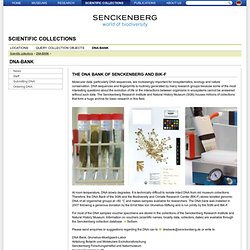
DNA sequences and fingerprints is routinely generated by many research groups because some of the most interesting questions about the evolution of life or the interactions between organisms in ecosystems cannot be answered without such data. The Senckenberg Research Institute and Natural History Museum (SGN) houses millions of collections that form a huge archive for basic research in this field. At room temperature, DNA slowly degrades. It is technically difficult to isolate intact DNA from old museum collections. For most of the DNA samples voucher specimens are stored in the collections of the Senckenberg Research Institute and Natural History Museum. Please send enquiries or suggestions regarding the DNA can to dnabank@senckenberg.de or write to: GeneWatch. > Current Issue > About GeneWatch.
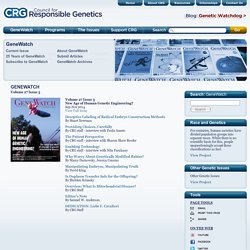
ASBH Home Page. Home. First monkeys with customized mutations born. Niu et al., Cell Twin cynomolgus monkeys born in China are the first with mutations in specific target genes.
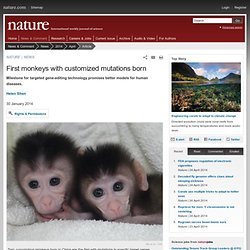
The ultimate potential of precision gene-editing techniques is beginning to be realised. Today, researchers in China report the first monkeys engineered with targeted mutations1, an achievement that could be a stepping stone to making more realistic research models of human diseases. Xingxu Huang, a geneticist at the Model Animal Research Center of Nanjing University in China, and his colleagues successfully engineered twin cynomolgus monkeys (Macaca fascicularis) with two targeted mutations using the CRISPR/Cas9 system — a technology that has taken the field of genetic engineering by storm in the past year.
Researchers have leveraged the technique to disrupt genes in mice and rats2, 3, but until now none had succeeded in primates. Primate push. NCBI Human Genome Resources. Useful online resources on ELSI of human genomics. GenBank Home. INSD Collaboration. All Resources - Site Guide - NCBI. CGS : Personal genomics. Home - Epigenomics - NCBI. Epigenomics Fact Sheet. Epigenomics What is the epigenome?

A genome is the complete set of deoxyribonucleic acid, or DNA, in a cell. DNA carries the instructions for building all of the proteins that make each living creature unique. Derived from the Greek, epigenome means "above" the genome. The epigenome consists of chemical compounds that modify, or mark, the genome in a way that tells it what to do, where to do it and when to do it. Top of page What does the epigenome do? Each person's body contains trillions of cells, all of which have essentially the same genome. The protein-coding parts of your genome, called genes, do not make proteins all of the time in all of your cells.
So, the epigenome is what tells your skin cells to behave like skin cells, heart cells like heart cells and so on. What makes up the epigenome? Hologenomics & Hologenome Sequencing Applications - Dr. Vinod Scaria. The American Journal of Human Genetics. News Bulletin of International HoloGenomics Society. Table of Contents For archived HoloGenomics News articles see Archives above Latest News.

Cloning and Human Genetic Manipulation. DNA Stores MLK's Speech, Shakespeare's Sonnets. A team of scientists in the U.K. has encoded text, sound files and a photograph onto strings of DNA, and successfully retrieved it without errors.
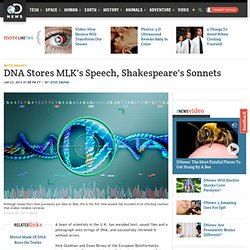
Nick Goldman and Ewan Birney of the European Bioinformatics Institute at the European Molecular Biology Laboratory used DNA to store a set of Shakespeare's sonnets, a recording of Martin Luther King's "I Have a Dream" speech, a photograph of the laboratory and an early research paper by James Watson and Francis Crick, who discovered DNA. Goldman and Birney then read back the data with 100 percent accuracy. Although researchers have previously put data on DNA, this is the first time anyone has included error-checking routines that enable reliable retrieval. Storing data on DNA has many advantages. DNA storage is far more compact than conventional memory.
Learn.Genetics™ The BioBrick™ Public Agreement (BPA) Welcome to Reactome Pathway Database.